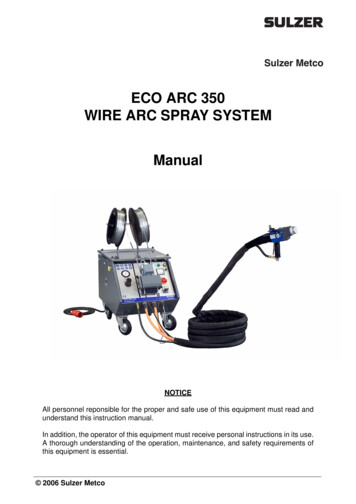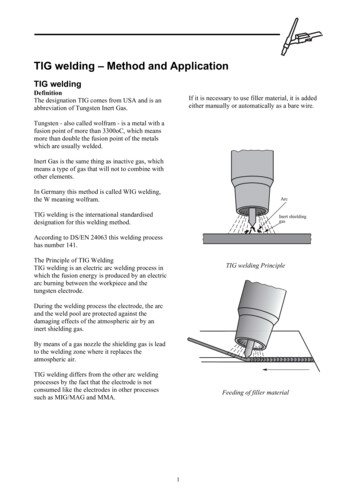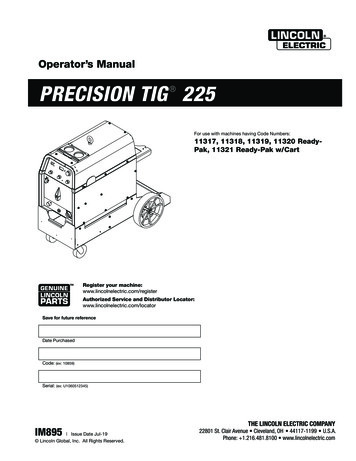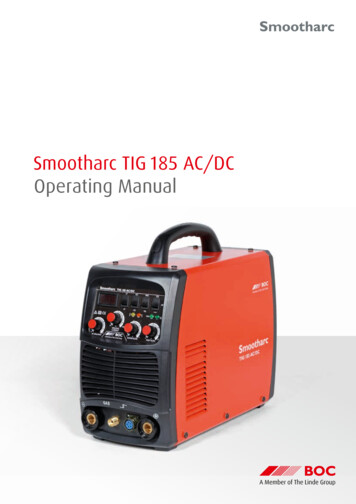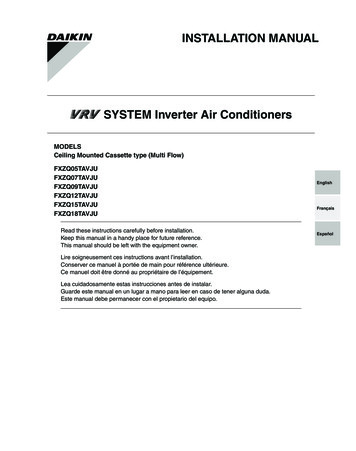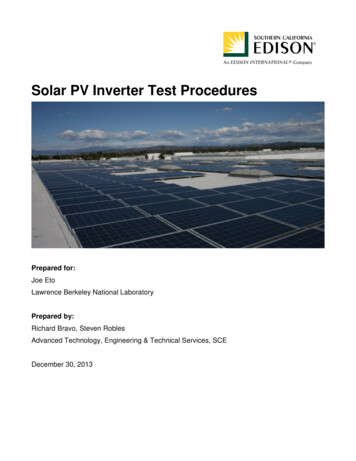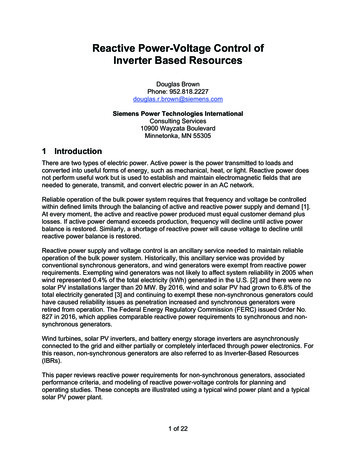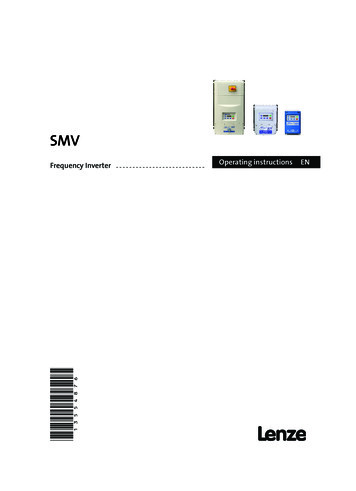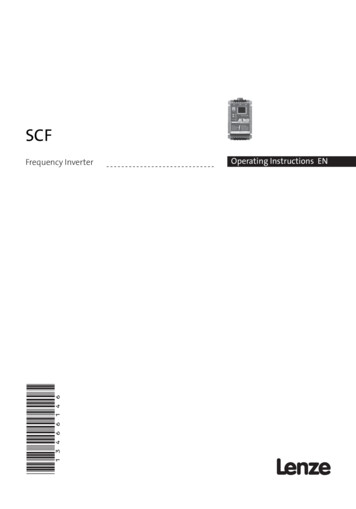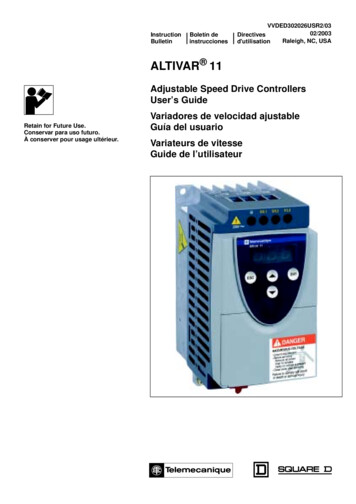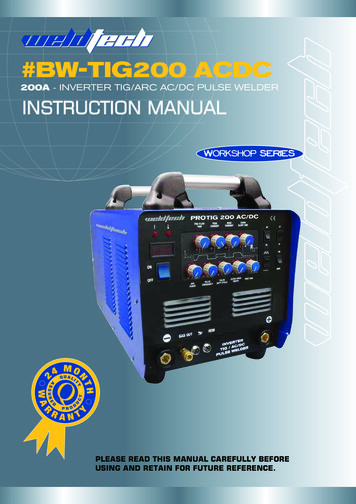
Transcription
#BW-TIG200 ACDC200A - INVERTER TIG/ARC AC/DC PULSE WELDERINSTRUCTION MANUALPLEASE READ THIS MANUAL CAREFULLY BEFOREUSING AND RETAIN FOR FUTURE REFERENCE.
CONTENTSSAFETY INFORMATION .3OVERVIEW .7UNPACKING YOUR MACHINE .7MACHINE SPECIFICATIONSKNOW YOUR WELDER.7.8CONSUMABLES & ACCESSORIES .9WELDER INSTALLATION .10MMA WELDING OPERATION .10DC TIG WELDING OPERATION .10DC PULSE TIG WELDING OPERATION .10AC TIG WELDING OPERATION .10AC PULSE TIG WELDING OPERATION .10MMA WELDING GUIDE.11MMA WELDING TROUBLESHOOTING.15TIG WELDING GUIDE .16TIG WELDING TROUBLESHOOTING .18MACHINE CARE & MAINTENANCE .19WARRANTY.20CONGRATULATIONS ON THE PURCHASE OF YOUR NEW WELDTECH BW-TIG200ACDC DIGITALINVERTER 200 AMP TIG ACDC WELDING MACHINE.PLEASE ENSURE YOU HAVE FAMILIARISED YOURSELF WITH THE INSTRUCTIONAL DVD AND READ THECONTENTS OF THIS MANUAL BEFORE USING YOUR MACHINE.2
SAFETY INFORMATIONGENERAL SAFETY WARNINGSWELDING SAFETY INSTRUCTIONS & WARNINGSSTORE AND RETAIN THIS MANUALRetain this manual for the safety warnings andprecautions, assembly, operating, inspection,maintenance and cleaning procedures. Write theproduct’s serial number into the NOTES section atthe rear, and keep this manual and the receipt in asafe and dry place for future reference.1. Maintain labels and nameplates on the welder.These carry important information. If unreadableor missing, contact your nearest Weldtech Storefor a replacement.IMPORTANT SAFETY INFORMATION3. Unplug before performing maintenance. Alwaysunplug the Welder from its electrical outlet beforeperforming any inspection, maintenance, or cleaning procedures.WARNINGPROTECT YOURSELF AND OTHERS FROMPOSSIBLE SERIOUS INJURY OR DEATH.KEEP CHILDREN AWAY. READ THE OPERATING/INSTRUCTION MANUAL BEFORE INSTALLING,OPERATING OR SERVICING THIS EQUIPMENT.HAVE ALL INSTALLATION, OPERATION,MAINTENANCE, AND REPAIR WORK PERFORMEDBY QUALIFIED PEOPLE.Failure to follow the warnings and instructions mayresult in electric shock, fire, serious injury and/ordeath. Save all warnings and instructions for futurereference.This is the safety alert symbol to alert you topotential personal injury hazards. Obey all safetymessages that follow this symbol to avoid possibleinjury or death.DANGER indicates a hazardous situationwhich, if not avoided, will result in death or seriousinjury.WARNING indicates a hazardous situationwhich, if not avoided, could result in death orserious injury.CAUTION, used with the safety alert symbol,indicates a hazardous situation which, if notavoided, could result in minor or moderate injury.NOTE, used to address practices not related topersonal injury.CAUTION, without the safety alert symbol, is used toaddress practices not related to personal injury.2. Avoid unintentional starting. Make sure the welderis setup correctly and you are prepared to begin workbefore turning on the welder.4. Never leave the welder unattended while energised. Turn power off before leaving the welderunattended.5. Do not touch live electrical parts. Wear dry,insulating gloves. Do not touch the electrode or theconductor tong with bare hands. Do not wear wet ordamaged gloves.6. Protect yourself from electric shock. Do not usethe welder outdoors. Insulate yourself from thework piece and the ground. Use non-flammable,dry insulating material if possible, or use dry rubbermats, dry wood or plywood, or other dry insulatingmaterial large enough to cover the area of contactwith the work or the ground.7. Avoid inhaling dust. Some dust created by powersanding, sawing, grinding, drilling, cutting, weldingand other construction activities, contain chemicalsknown to cause cancer, birth defects or other harm.Your risk from these exposures varies, dependingon how often you do this type of work. To reduceyour exposure to these chemicals, work in awell-ventilated area, and work with approved safetyequipment, such as dust masks that are speciallydesigned to filter out microscopic particles.8. People with pacemakers should consult theirphysician(s) before using this machine.WARNINGElectromagnetic fields in close proximity to a heartpacemaker could cause interference, or failure ofthe pacemaker. The use of a Welder is NOTRECOMMENDED for pacemaker wearers. Consultyour doctor.9. Ensure that the unit is placed on a stable locationbefore use.WARNINGIf this unit falls while plugged in, severe injury,electric shock, or fire may result.10. Transportation MethodsCAUTIONDisconnect input power conductors fromde-energized supply line before moving the weldingpower source.Lift unit with the handles provided, or use ahandcart or similar device of adequate capacity.If using a fork lift vehicle, secure the unit to a skidbefore transporting.11. Exericse good work practices. The warnings,precautions, and instructions discussed in thisinstruction manual cannot cover all possibleconditions and situations that may occur. It must beunderstood by the operator that common sense andcaution are factors which cannot be built into thisproduct, but must be considered by the operator.3If an operator does not strictly observe all safetyrules and take precautionary actions, weldingproducts and welding processes can cause seriousinjury or death, or damage to other equipment orproperty.Safe practices have developed from pastexperience in the use of welding and cutting.These practices must be learned through studyand training before using this equipment. Some ofthese practices apply to equipment connected topower lines; other practices apply to engine drivenequipment. Anyone not having extensive training inwelding and cutting practices should not attemptto weld.Safe practices are outlined in the EuropeanStandard EN60974-1 entitled: Safety in weldingand allied processes.WARNINGOnly use safety equipment that has been approvedby an appropriate standards agency. Unapprovedsafety equipment may not provide adequateprotection. Eye and breathing protection must beAS/NZS compliant for the specific hazards in thework area.DANGERAlways wear AS/NZS compliant safety glasses anda full face shield fitted with the appropriate filtershade number. (Refer Filter Table on page 6.)CAUTIONHeavy-duty work gloves, non-skid safety shoes andhearing protection used for appropriate conditionswill reduce personal injuries.CAUTIONHave the equipment serviced by a qualified repairperson using identical replacement parts. This willensure that the safety of the power tool ismaintained.
PERSONAL SAFETYCAUTIONKeep the work area well lit. Make sure thereis adequate space surrounding the work area.Always keep the work area free of obstructions,grease, oil, trash, and other debris. Do not useequipment in areas near flammable chemicals,dust, and vapours. Do not use this product in adamp or wet location.1. Stay alert, watch what you are doing and usecommon sense when operating equipment.Do not use a tool while you are tired or underthe influence of drugs, alcohol or medication. Amoment of distraction when operating equipmentmay result in serious personal injury.2. Do not overreach. Keep proper footing andbalance at all times. This enables better control ofthe power tool in unexpected situations.ARC RAYS CAN BURN EYES AND SKINDANGERArc rays from the welding process produceintense heat and strong ultraviolet rays that canburn eyes and skin.1. Use a Welding Helmet or Welding FaceShield fitted with a proper shade filter(refer AS 60974-1, AS/NZS 1337.1 andAS/NZS 1338.1 Safety Standards) to protectyour face and eyes when welding or watching.(See Filter Table on Page 6).2. Wear approved safety glasses. Side shieldsare recommended.3. Use protective screens or barriers to protectothers from flash and glare; warn others not towatch the arc.4. Wear protective clothing made from durable,flame-resistant material (wool and leather) andfoot safety protection.5. Never wear contact lenses while welding.NOISE CAN DAMAGE HEARINGCAUTIONNoise from some processes can damagehearing. Use AS/NZS compliant ear plugs or earmuffs if the noise level is high.WORK ENVIRONMENT SAFETYDANGERRemove any combustible material from the work area.1. When possible, move the work to a location wellaway from combustible materials. If relocationis not possible, protect the combustibles with acover made of fire resistant material.2. Remove or make safe all combustible materialsfor a radius of 10 meters around the work area.Use a fire resistant material to cover or block alldoorways, windows, cracks, and other openings.3. Enclose the work area with portable fire resistantscreens. Protect combustible walls, ceilings,floors, etc., from sparks and heat with fireresistant covers.4. If working on a metal wall, ceiling, etc., p
Always keep the work area free of obstructions, grease, oil, trash, and other debris. Do not use equipment in areas near flammable chemicals, dust, and vapours. Do not use this product in a damp or wet location. 1. Stay alert, watch what you are doing and use common sense when operating equipment. Do not use a tool while you are tired or under
